Within this guide, you will discover a comprehensive resource to help you identify and familiarize yourself with the 20 unique species of sparrows found in Maine. Not only will you learn to recognize them by sight, but you will also have the opportunity to familiarize yourself with their distinct songs. Additionally, you will find information on the optimal times of the year to spot these sparrows and some intriguing facts about each species.
Taking the time to acquaint yourself with these lively and melodious songbirds will prove to be a delightful experience, as they offer captivating sights and harmonious tunes. It’s worth noting that both Juncos and Towhees fall under the sparrow category and are included in this comprehensive guide.
Bird enthusiasts often refer to sparrows as “little brown jobs,” which emphasizes the challenge even experienced birders face when it comes to recognizing them. However, many sparrows exhibit unique head markings and engage in migratory behavior, which can aid in their identification. This guide includes these key details to facilitate accurate identification.
Sparrows predominantly feed on seeds and insects, making backyard feeders a common attraction for them. Alongside information about sparrows, you will also discover a list of other bird species regularly seen in Maine and a convenient printable chart for identification purposes.
This guide has been carefully curated to provide accurate information about the sparrows regularly observed in Maine. It relies on avibase data, which classifies these species as regularly occurring, and incorporates real data contributed by dedicated bird watchers through ebird.
Determining the optimal times to spot sparrows in Maine can significantly reduce guesswork when it comes to identifying these birds with similar appearances. To enhance your birding experience, this guide conveniently categorizes the sparrows based on the periods when they are most likely to be observed.
Sparrows Present in Maine Throughout the Year:
1. Dark-eyed Junco
2. House Sparrow
Sparrows Found in Maine During Summer:
1. Song Sparrow
2. Chipping Sparrow
3. White-throated Sparrow
4. Savannah Sparrow
5. Swamp Sparrow
6. Eastern Towhee
7. Lincoln’s Sparrow
8. Field Sparrow
9. Nelson’s Sparrow
10. Vesper Sparrow
11. Saltmarsh Sparrow
12. Grasshopper Sparrow
Sparrows Found in Maine During Winter:
1. American Tree Sparrow
Additional Sparrow Species in Maine:
1. Seaside Sparrow
Sparrows Encountered in Maine During Migration:
1. White-crowned Sparrow
2. Fox Sparrow
3. Clay-colored Sparrow
4. Lark Sparrow
Unveiling the Songs of Sparrows
Immerse yourself in the enchanting songs of sparrows by acquainting yourself with the audio recordings featured in this guide. Familiarizing yourself with their unique melodies will prove especially helpful in identifying sparrows with distinct songs. For instance, the White-throated Sparrow emits long, melodic notes that transition in pitch, resembling a human whistling. Meanwhile, the Field Sparrow’s song accelerates into a high trill, akin to a bouncing ball coming to a halt. Have you ever encountered the peculiar buzz of the Grasshopper Sparrow?
Sparrows in Maine Throughout the Year:
1. Dark-eyed Junco
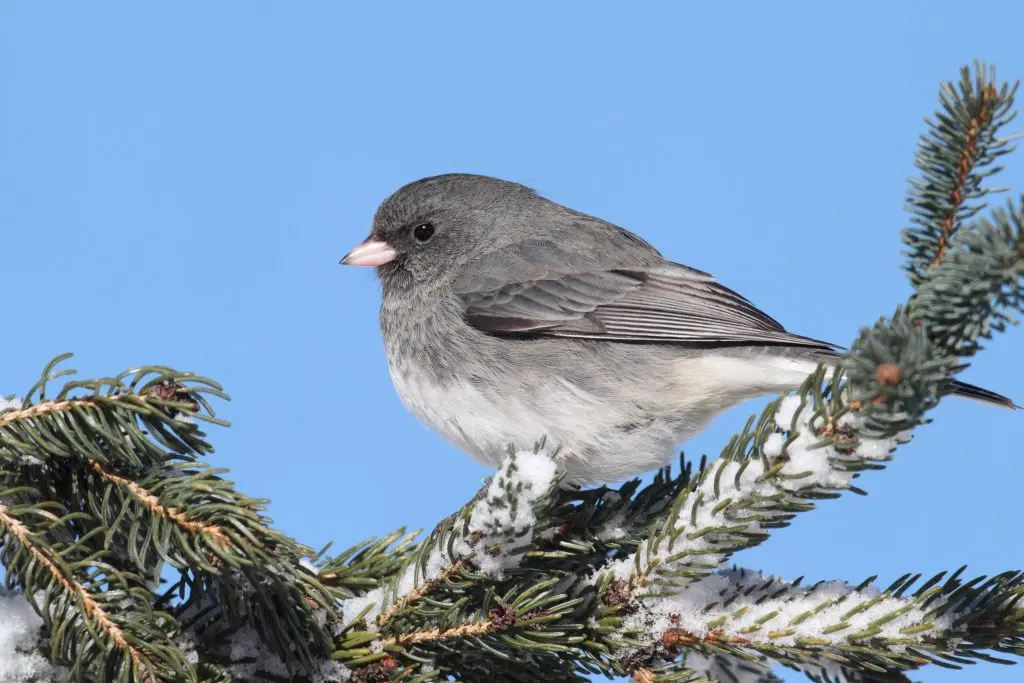
During the winter season, the Dark-eyed Junco reigns supreme as the most frequently observed sparrow in Maine. They are commonly sighted from October to April and are present in a remarkable 20% of winter checklists and 8% of summer checklists.
Dark-eyed Juncos exhibit color variations across different regions. In the east, they generally appear slate-colored, while their counterparts in the west display a combination of black, white, and brown.
Junco hyemalis
Length: 5.5-6.3 in (14-16 cm)
Weight: 0.6-1.1 oz (18-30 g)
Wingspan: 7.1-9.8 in (18-25 cm)
Dark-eyed Juncos are year-round residents in the northeastern and western United States, as well as the Appalachian Mountains. However, those breeding in Canada and Alaska migrate southward to the United States during winter.
You can easily spot Dark-eyed Juncos in open areas with partial woodland coverage. They often roam the ground and are widespread throughout the continent. Their diet primarily consists of seeds, with occasional insect consumption.
Dark-eyed Junco sounds: Their simple song comprises a rapid succession of high-pitched, evenly spaced notes.
Credit: Bobby Wilcox, XC667170. Accessible at www.xeno-canto.org/667170.
Dark-eyed Junco nests are typically hidden amidst vegetation on the ground. Constructed from plant materials, they feature a lining of grass and hair. Each clutch contains up to six eggs, which take approximately two weeks to hatch. The young juncos require an additional two weeks before leaving the nest.
Attract Dark-eyed Juncos to your backyard feeders by offering a diverse selection of seeds such as black oil sunflower seeds, nyjer, cracked corn, millet, and peanuts. Platform feeders or scattering seeds on the ground are optimal feeding methods.
Fun fact: Dark-eyed Juncos earned the nickname “snowbirds” due to their wintertime arrival in the United States.
2. House Sparrow

House Sparrows, introduced to Maine, can be observed throughout the year. They do not migrate and are recorded in 8% of summer checklists and 10% of winter checklists in the state.
Characterized by gray and brown heads with white cheeks and a black bib, House Sparrows boast black and brown backs, while their bellies exhibit shades of gray. Female House Sparrows possess an overall browner appearance and lack the black bib.
Passer domesticus
Length: 5.9-6.7 in (15-17 cm)
Weight: 0.9-1.1 oz (27-30 g)
Wingspan: 7.5-9.8 in (19-25 cm)
House Sparrows are year-round inhabitants of the United States and southern Canada.
You can often find House Sparrows near human dwellings and structures. They display a relatively tame nature and may even feed from your hand. However, their presence can be problematic for native birds, as they secure prime nesting spots before the arrival of their native counterparts.
House Sparrows primarily consume grains, seeds, and discarded food. Though considered non-native pests, they frequent backyards regardless of provided feeders.
House Sparrow sounds: Their song consists of a series of simple notes.
Credit: Olivier SWIFT, XC697951. Accessible at www.xeno-canto.org/697951.
House Sparrow nests are concealed within small openings in buildings, dense vegetation, or nest boxes. Constructed from dry grass and plant materials, they feature a lining of feathers and soft materials.
Females lay up to eight eggs, and they can produce up to four broods in a year. The incubation period lasts less than two weeks, and the chicks require another two weeks to fledge.
Attract House Sparrows to your backyard feeders using various birdseeds, including millet, corn, and sunflower seeds.
Fun fact: Besides North America, House Sparrows have been introduced to South America, Australia, New Zealand, and South Africa.
Sparrows in Maine during Summer:
1. Song Sparrow
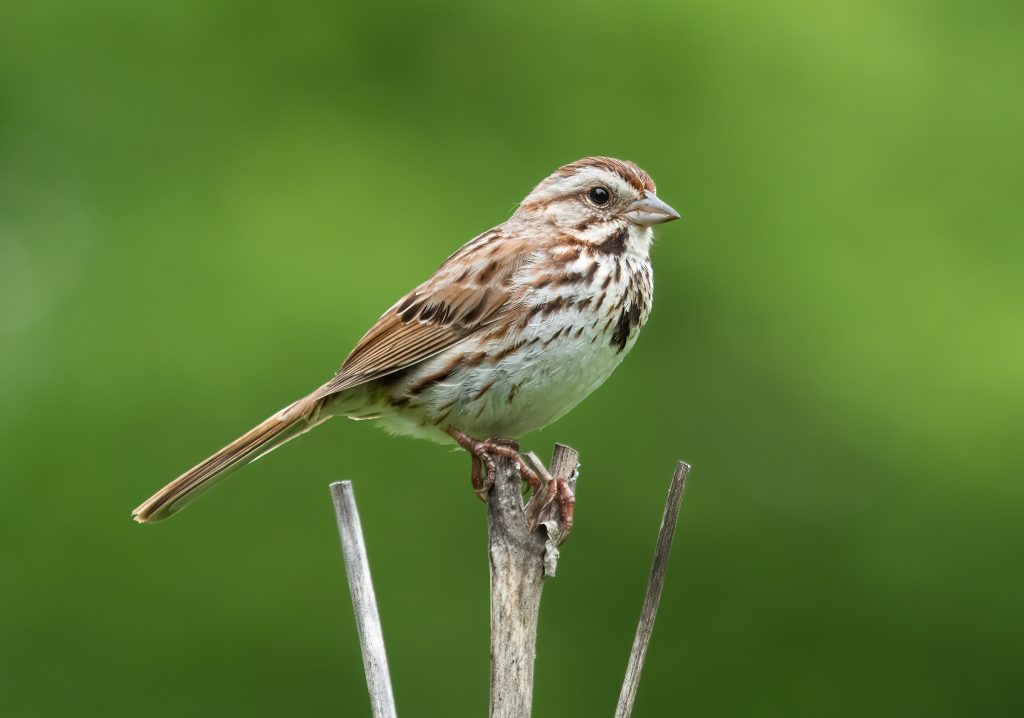
Song Sparrows are most commonly sighted in Maine during the summer season, making them the fifth most frequently observed sparrows during winter as well. While they can be seen throughout the year, they are more prevalent during the breeding period from March to October.
They appear in 47% of summer checklists and 6% of winter checklists submitted by bird watchers in the state.
Song Sparrows may not boast the most remarkable appearance among backyard birds, but their predominantly brown-streaked plumage serves them well when serenading potential mates during the spring and summer seasons.
Melospiza melodia
Length: 4.7-6.7 in (12-17 cm)
Weight: 0.4-1.9 oz (12-53 g)
Wingspan: 7.1-9.4 in (18-24 cm)
Song Sparrows are year-round residents in the northern United States. Those breeding in Canada migrate to southern states for the winter.
You can easily spot Song Sparrows in open, shrubby, and wet areas. They are often found perched on low shrubs, and they frequently visit backyard feeders.
Song Sparrows possess a diverse diet, which includes various insects such as beetles, caterpillars, midges, spiders, and earthworms. They also consume buckwheat, sunflower seeds, raspberries, wild cherries, blackberries, wheat, and rice.
Song Sparrow sounds: Their vocalizations consist of a series of unconnected buzzing trills and notes, rather than a melodious song. Additionally, they emit sharp alarm calls and chatter when in groups.
Credit: Christopher McPherson, XC692182. Accessible at www.xeno-canto.org/692182.
Song Sparrow nests are skillfully woven from grass and other plant materials, with a lining of soft grass and hair. Each clutch comprises up to six eggs, requiring around two weeks to hatch. The young then spend just under two weeks in the nest before fledging.
Attract Song Sparrows to your backyard by providing black oil sunflower seeds, cracked corn, and nyjer on platform feeders.
Fun fact: A study has shown that Song Sparrows constantly change their song playlist to avoid repetition and potential boredom for prospective females!
2. Chipping Sparrow
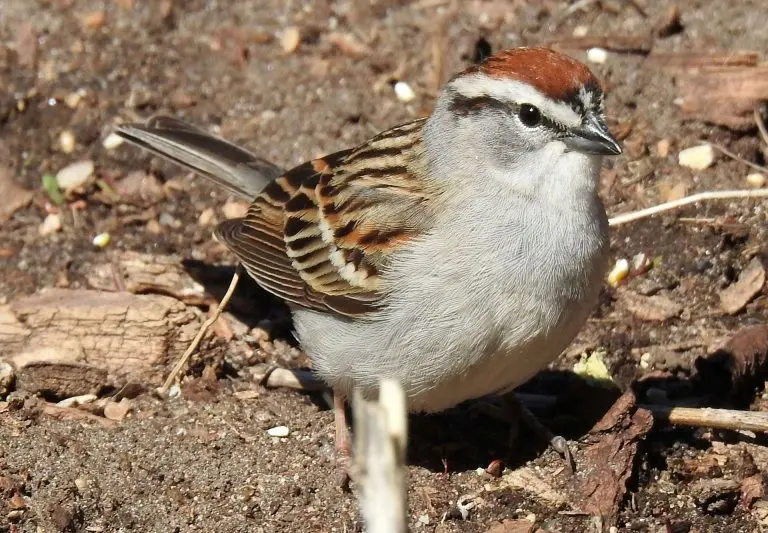
Chipping Sparrows are the second most commonly observed sparrows in Maine during the summer months. They are particularly abundant from April to November, with a presence recorded in 26% of summer checklists. However, a few individuals can be spotted throughout the year.
Chipping Sparrows possess a slender frame, displaying streaks of brown and black on their back, a grayish belly, and a rusty crown. In the winter, their colors become more subdued.
Spizella passerina
Length: 4.7-5.9 in (12-15 cm)
Weight: 0.4-0.6 oz (11-16 g)
Wingspan: 8.3 in (21 cm)
Chipping Sparrows breed in the United States and Canada during the summer months, while some remain in the southern states throughout the year.
You can easily find Chipping Sparrows in small flocks foraging on the ground, particularly in wooded areas, parks, and regions with abundant trees.
Chipping Sparrow sounds: They derive their name from their sharp “chip” call. Their unique song is a rapid trill that ends with a high-pitched note, often likened to a bouncing ball coming to a stop.
Credit: Richard E. Webster, XC611297. Accessible at www.xeno-canto.org/611297.
Chipping Sparrows feed on a diverse range of seeds, including grass, weed seeds, and grains. They also consume insects during the breeding season.
Chipping Sparrow nests are often located in trees or shrubs, at times in close proximity to human dwellings. Constructed from grass, pine needles, rootlets, and plant stems, they feature a lining of fine grass, hair, and feathers.
Each clutch typically contains three to five eggs, requiring around two weeks to hatch. The young Chipping Sparrows fledge within two weeks of hatching.
Attract Chipping Sparrows to your backyard by offering a variety of seeds such as sunflower, millet, and cracked corn in feeders placed at different heights.
Fun fact: Chipping Sparrows tend to migrate during the night, making their migration patterns less noticeable compared to other bird species.
3. White-throated Sparrow
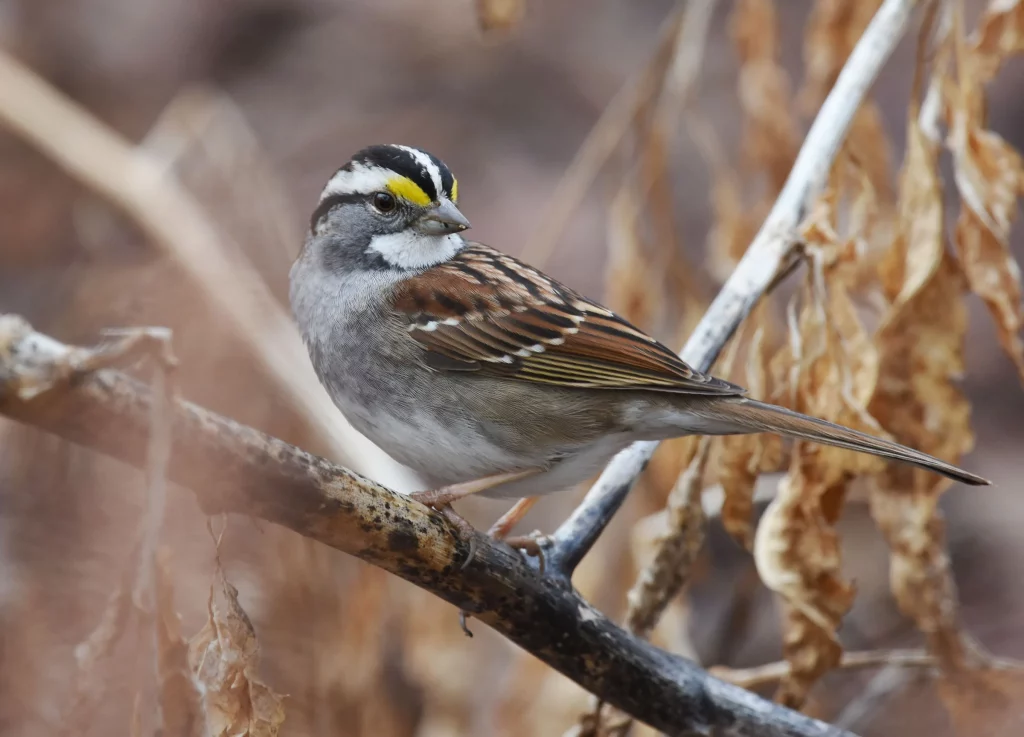
White-throated Sparrows are prevalent in Maine during the summer season. They are observed in 37% of summer checklists, making them the third most frequently encountered sparrows during this period.
White-throated Sparrows are adorned with distinctive markings, including a bold white throat patch bordered by black stripes. They also exhibit a yellow spot between the eye and bill.
Zonotrichia albicollis
Length: 5.9-6.7 in (15-17 cm)
Weight: 0.9-1.1 oz (26-31 g)
Wingspan: 7.9-8.7 in (20-22 cm)
White-throated Sparrows breed in Canada and the northeastern United States, migrating southward during winter to the southern United States and Mexico.
You can often find White-throated Sparrows foraging on the ground, particularly in forests, wood edges, and shrubby habitats.
White-throated Sparrow sounds: Their most recognized song consists of clear, whistled notes that resemble the phrase “Oh, sweet Canada, Canada, Canada.” However, some individuals exhibit different song variants, such as “Old Sam Peabody, Peabody, Peabody” or “Sweet, sweet, sweet, I’m so sweet.”
Credit: Greg Irving, XC534540. Accessible at www.xeno-canto.org/534540.
White-throated Sparrows primarily consume seeds, including those of grasses, weeds, and shrubs. They also consume insects, especially during the breeding season.
White-throated Sparrow nests are usually located on or near the ground, concealed within shrubs or dense vegetation. Constructed from twigs, grass, leaves, and rootlets, they feature a lining of fine grasses and hair.
Each clutch typically contains three to five eggs, requiring approximately two weeks to hatch. The young sparrows fledge within ten days to two weeks after hatching.
Attract White-throated Sparrows to your backyard by providing a mix of seeds, including sunflower seeds, cracked corn, and millet.
Fun fact: White-throated Sparrows exhibit distinct morphs, known as tan-striped and white-striped, based on the coloration of their head stripes.
4. Savannah Sparrow
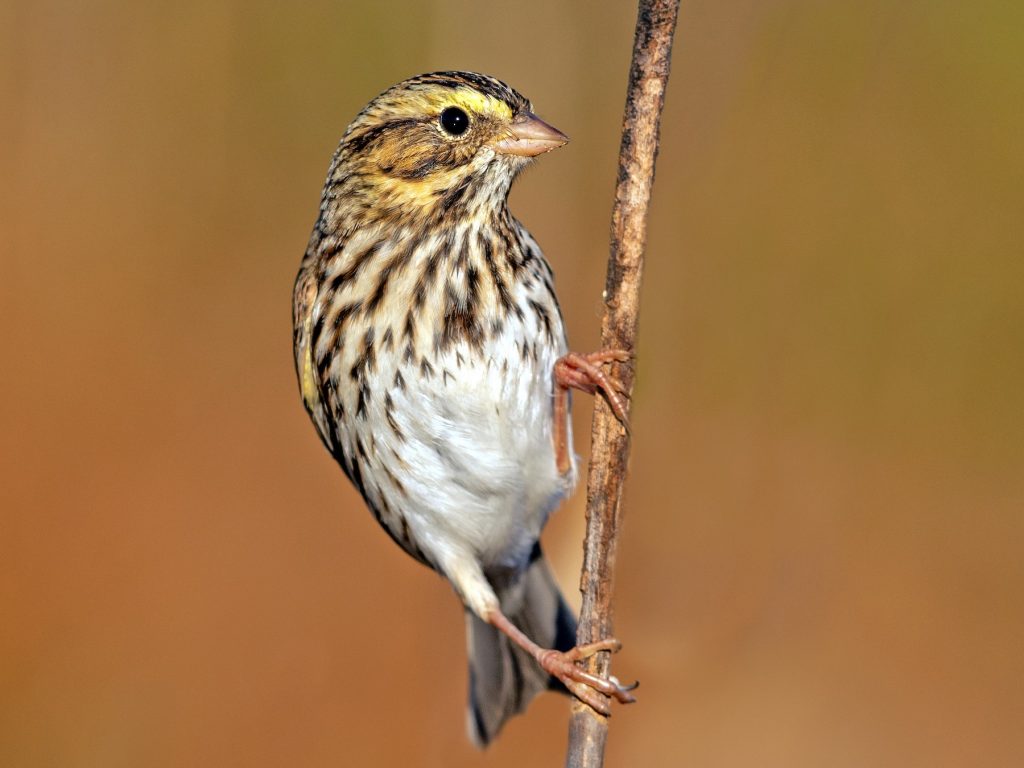
Savannah Sparrows are another commonly observed sparrow species in Maine during the summer season. They are present in 31% of summer checklists.
These sparrows exhibit varied appearances depending on their region, but they typically possess a streaked brown back, a pale eyebrow stripe, and a yellowish patch above the eye.
Passerculus sandwichensis
Length: 4.7-5.9 in (12-15 cm)
Weight: 0.4-0.7 oz (11-20 g)
Wingspan: 7.9-9.4 in (20-24 cm)
Savannah Sparrows breed in Alaska, Canada, and the northern United States. During winter, they migrate to the southern United States and Mexico.
Savannah Sparrows frequent grassy habitats such as meadows, fields, marshes, and coastal areas. They are often observed perched on fence wires or low vegetation.
Savannah Sparrow sounds: Their song consists of a series of clear, thin notes, similar to the sound of a sewing machine.
Credit: Dominic Garcia-Hall, XC650573. Accessible at www.xeno-canto.org/650573.
Savannah Sparrows primarily consume seeds, including those of grasses and weeds. They also consume insects during the breeding season.
Savannah Sparrow nests are located on the ground, often hidden within grass or vegetation. Constructed from grasses, moss, and plant stems, they feature a lining of finer grasses and hair.
Each clutch typically contains three to five eggs, requiring approximately two weeks to hatch. The young sparrows fledge within ten days to two weeks after hatching.
Attract Savannah Sparrows to your backyard by creating a grassy area with native grasses and providing a mix of seeds in ground or platform feeders.
Fun fact: Savannah Sparrows have a wide range of subspecies, with slight variations in plumage patterns and coloration depending on their geographical location.
Certainly! Here are the next six sparrow species that can be found in Maine during the summer season:
5. Eastern Towhee

Eastern Towhees can be spotted in Maine during the summer, from April to October. They are recognized in 19% of summer checklists.
Eastern Towhees are distinctive with their black head, throat, and back, reddish sides, and white belly in males. Females have similar patterns but with a brown coloration instead of black.
Pipilo erythrophthalmus
Length: 6.8-8.2 in (17-21 cm)
Weight: 1.1-1.8 oz (31-51 g)
Wingspan: 7.9-11 in (20-28 cm)
Eastern Towhees are year-round residents in the southeastern United States. However, northern populations migrate south for the winter.
You can find Eastern Towhees in areas with dense shrubs and undergrowth, such as forests, thickets, and overgrown fields.
Eastern Towhee sounds: Their song begins with a sharp note followed by a series of rising and falling trills.
Credit: Richard E. Webster, XC691323. Accessible at www.xeno-canto.org/691323.
Eastern Towhees primarily feed on insects, spiders, and seeds. They use a “double-scratch” method to forage by hopping backward and kicking debris to uncover food.
Eastern Towhee nests are typically constructed on or near the ground, hidden within vegetation. Females build the nests using leaves, grass, bark, and rootlets. They lay around 2-6 eggs, which take about two weeks to hatch. The young towhees fledge within 9-13 days.
To attract Eastern Towhees to your backyard, provide shrubby areas and scatter seeds such as millet, cracked corn, and sunflower seeds on the ground.
Fun fact: Male Eastern Towhees perform a unique hopping dance during courtship displays, sometimes accompanied by a series of calls.
6. Lincoln’s Sparrow
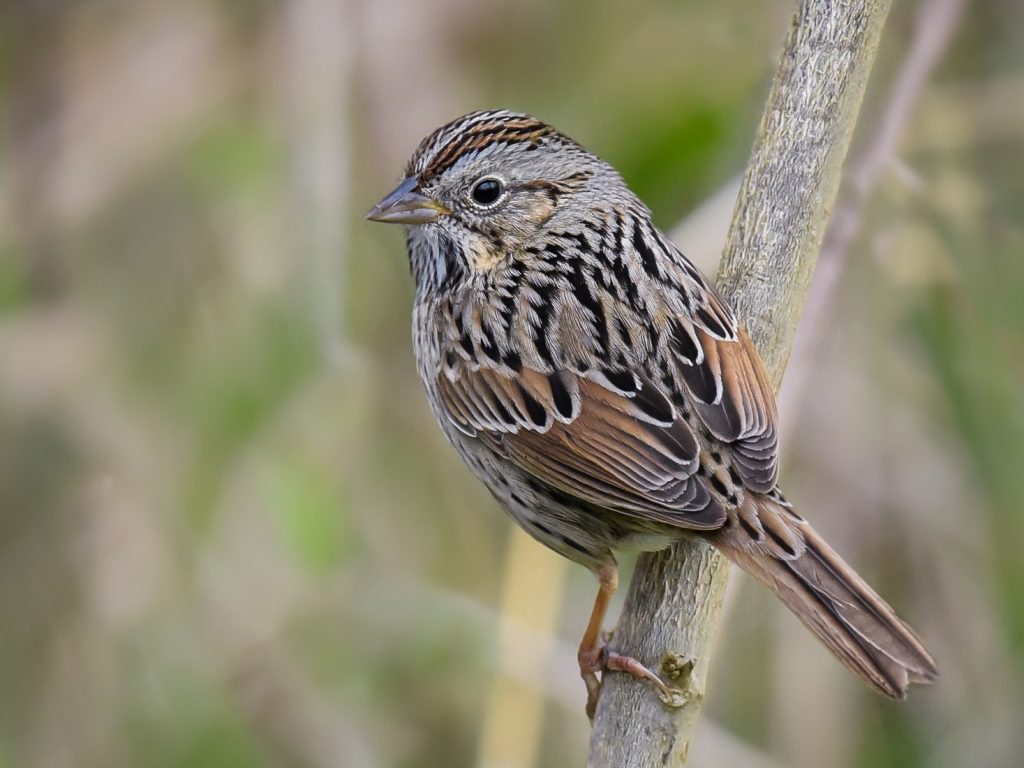
Lincoln’s Sparrows can be found in Maine from April to January. They are more commonly observed during the fall migration in September and October. During this period, they are mostly seen along the coast.
Lincoln’s Sparrows have gray-brown backs with streaks and a pointed crown. Their undersides are gray, and they have a buffy eyering and a dark eye line.
Melospiza lincolnii
Length: 4.5-5.5 in (11-14 cm)
Weight: 0.6-0.8 oz (17-23 g)
Wingspan: 6.5-7.9 in (17-20 cm)
Lincoln’s Sparrows breed in central and western Canada and migrate to the United States during winter. They can be observed during migration across various regions.
You can find Lincoln’s Sparrows in dense shrubs and thickets near streams, wet areas, and marshes. During winter, they migrate to tropical forests with dense vegetation.
Lincoln’s Sparrows primarily feed on seeds and insects. During the breeding season, they consume insects like spiders, ants, and caterpillars, while still providing plant matter to their young.
Lincoln’s Sparrow sounds: Their song is a fast trill of notes, often melodious and pleasant to the ear.
Credit: Richard E. Webster, XC574895. Accessible at www.xeno-canto.org/574895.
Nests of Lincoln’s Sparrows are built near the ground by females. They construct the nests using grasses and other plant materials. They lay around 3-5 eggs, which take under two weeks to hatch. The young sparrows leave the nest within a week or two after hatching.
Fun fact: Lincoln’s Sparrows are known for their secretive nature, making them less commonly seen but easily recognizable by their beautiful song.
7. Field Sparrow
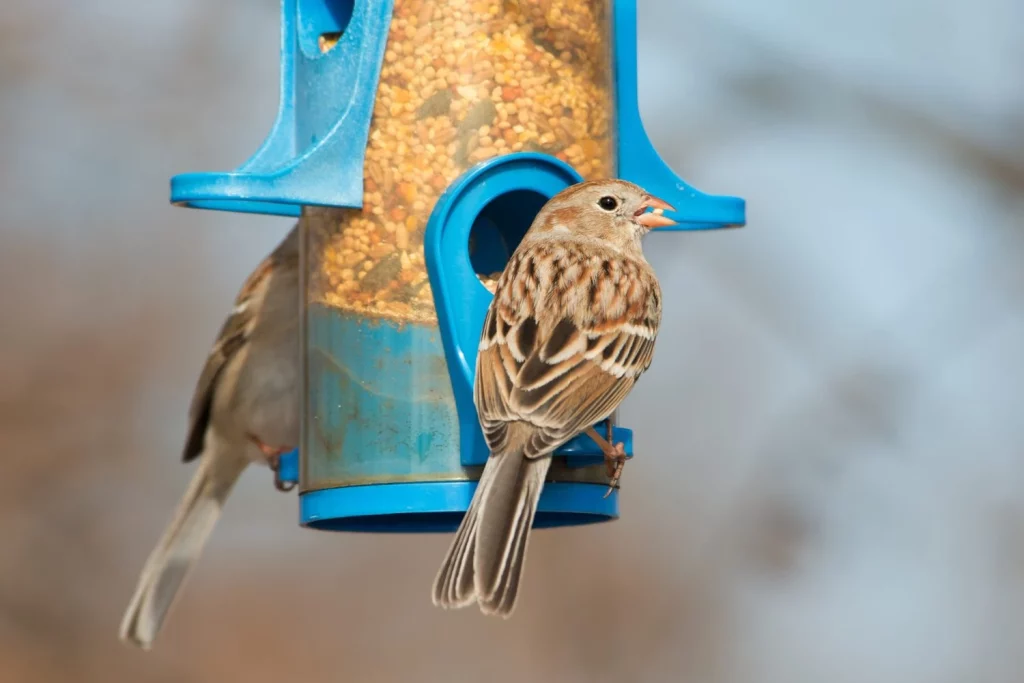
Field Sparrows can be spotted in Maine during the summer, from April to October. They are recorded in 1% of summer checklists.
Field Sparrows are small, slender birds with brown backs streaked with black. Their undersides are gray, and they have reddish crowns and pink bills.
Spizella pusilla
Length: 4.7-5.9 in (12-15 cm)
Weight: 0.4-0.5 oz (11-14 g)
Wingspan: 7.9 in (20 cm)
Field Sparrows are year-round residents in the eastern United States. However, some individuals breeding in the Midwest migrate south for the winter.
You can find Field Sparrows in abandoned fields, meadows, and grassy areas. They are often heard singing from perches in the early mornings.
Field Sparrow sounds: Their song starts with a few slow notes and then rapidly speeds up into a trill.
Credit: Christopher McPherson, XC601031. Accessible at www.xeno-canto.org/601031.
Field Sparrows primarily feed on seeds and insects. They have a particular fondness for weed and grass seeds.
Nests of Field Sparrows are built on the ground during the first brood, gradually becoming higher off the ground as the breeding season progresses. They construct nests using grass, leaves, and other plant materials. Field Sparrows lay around 3-5 eggs, which take about two weeks to hatch. The young sparrows fledge within a week or two after hatching.
To attract Field Sparrows to your backyard, provide cracked corn, millet, and sunflower seeds.
Fun fact: Field Sparrows’ song is often compared to the sound of a bouncing ball coming to a stop.
8. Nelson’s Sparrow

Nelson’s Sparrows are not very common in Maine but can be spotted along the coast during the breeding season, from April to November.
Nelson’s Sparrows have orangish heads and chests, streaked brown backs, and gray bellies. Coastal birds generally have less vibrant colors compared to their inland counterparts.
Ammospiza nelsoni
Length: 4.3-5.1 in (11-13 cm)
Weight: 0.6-0.7 oz (17-20 g)
Wingspan: 6.5-7.9 in (17-20 cm)
Nelson’s Sparrows breed primarily in central Canadian provinces. During migration, they can be seen along the Gulf and Atlantic Coasts. They also migrate across the Great Plains.
You can find Nelson’s Sparrows in wetlands and marshes during the breeding season, where they forage for seeds and insects. In winter, they inhabit saltwater and brackish marshes.
Nelson’s Sparrow sounds:
Credit: Paul Marvin, XC282846. Accessible at www.xeno-canto.org/282846.
Nests of Nelson’s Sparrows are typically located close to the ground and constructed using grass by the female. They lay up to six eggs, which take under two weeks to hatch.
Fun fact: Male Nelson’s Sparrows perform fast and long flights just above marsh vegetation during courtship displays.
9. Vesper Sparrow

Vesper Sparrows are not frequently seen in Maine but breed in the southern part of the state during summer, from April to November.
Vesper Sparrows have mostly brown backs with white streaks and white bellies.
Pooecetes gramineus
Length: 5.1-6.3 in (13-16 cm)
Weight: 0.7-1.0 oz (20-28 g)
Wingspan: 8.7-9.1 in (22-23 cm)
Vesper Sparrows breed across the northern United States and southern Canada. They migrate to the southern United States and Mexico during winter.
You can find Vesper Sparrows in grasslands, prairies, open fields, and pastures. They often perch on fence wires or shrubs to sing their characteristic songs.
Vesper Sparrow sounds: Their song is a clear and musical series of notes that gradually ascend and then descend.
Credit: Richard E. Webster, XC572221. Accessible at www.xeno-canto.org/572221.
Vesper Sparrows primarily feed on seeds and insects. During the breeding season, insects make up a larger portion of their diet.
Nests of Vesper Sparrows are built on the ground by females. They lay around 3-6 eggs, which take about two weeks to hatch. The young sparrows fledge within a week or two after hatching.
Fun fact: The name “Vesper” refers to the sparrow’s habit of singing in the evening during the vesper hour.
10. Fox Sparrow

Fox Sparrows are not commonly seen in Maine but can be observed during their migration in spring and fall.
Fox Sparrows are large, sturdy sparrows with reddish-brown backs, streaked breasts, and gray faces. They show variation in color and patterns across their range.
Passerella iliaca
Length: 6.3-7.5 in (16-19 cm)
Weight: 1.0-1.5 oz (28-43 g)
Wingspan: 9.8-11 in (25-28 cm)
Fox Sparrows breed in the far northern regions of North America and migrate to the southern United States during winter.
You can find Fox Sparrows in dense thickets, forest edges, and shrubby areas. They often scratch the ground with both feet to uncover food.
Fox Sparrow sounds: They have a melodious and rich song with clear, low notes.
Credit: Ed Pandolfino, XC693559. Accessible at www.xeno-canto.org/693559.
Fox Sparrows primarily feed on seeds, insects, and berries. They have a particular preference for ground-feeding.
Nests of Fox Sparrows are built on or near the ground by females. They lay around 3-5 eggs, which take about two weeks to hatch. The young sparrows fledge within a week or two after hatching.
Fun fact: Fox Sparrows have distinct regional song dialects across their breeding range.
11. White-throated Sparrow
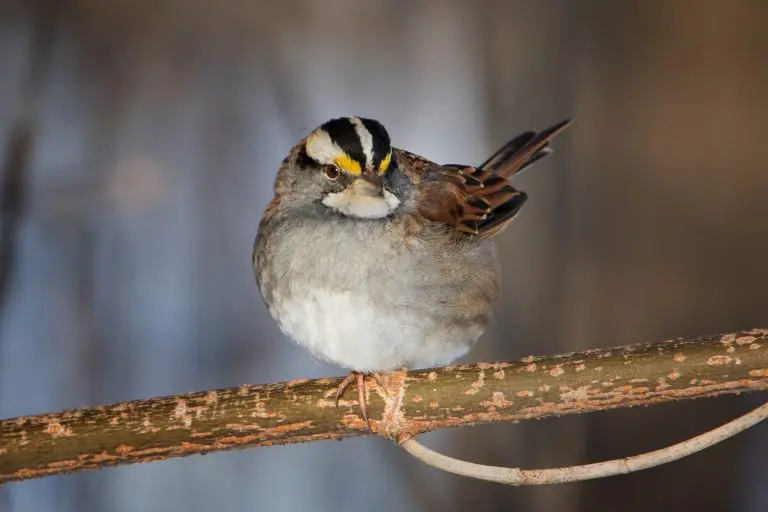
White-throated Sparrows are fairly common in Maine during the spring and fall migration, and some individuals may overwinter in the state.
White-throated Sparrows have gray-brown upperparts, a white throat, and a yellow patch between the eye and bill. They also have distinctive black and white head stripes, known as “crown stripes.”
Zonotrichia albicollis
Length: 6.3-7.5 in (16-19 cm)
Weight: 0.9-1.3 oz (26-37 g)
Wingspan: 8.7-9.8 in (22-25 cm)
White-throated Sparrows breed in the boreal forests of Canada and Alaska. They migrate to the southeastern and central United States during winter.
You can find White-throated Sparrows in forests, woodlands, and shrubby areas. They often forage on the ground, scratching leaf litter to uncover seeds and insects.
White-throated Sparrow sounds: Their song consists of a series of clear, whistled notes that are often described as “Oh sweet Canada, Canada, Canada.”
Credit: Richard E. Webster, XC572230. Accessible at www.xeno-canto.org/572230.
White-throated Sparrows primarily feed on seeds, berries, and insects. They have a preference for weed seeds and are frequent visitors to backyard bird feeders.
Nests of White-throated Sparrows are built on or near the ground by females. They lay around 3-5 eggs, which take about two weeks to hatch. The young sparrows fledge within a week or two after hatching.
Fun fact: White-throated Sparrows exhibit distinct regional song dialects, with different populations singing slightly different variations of their song.
12. Harris’s Sparrow
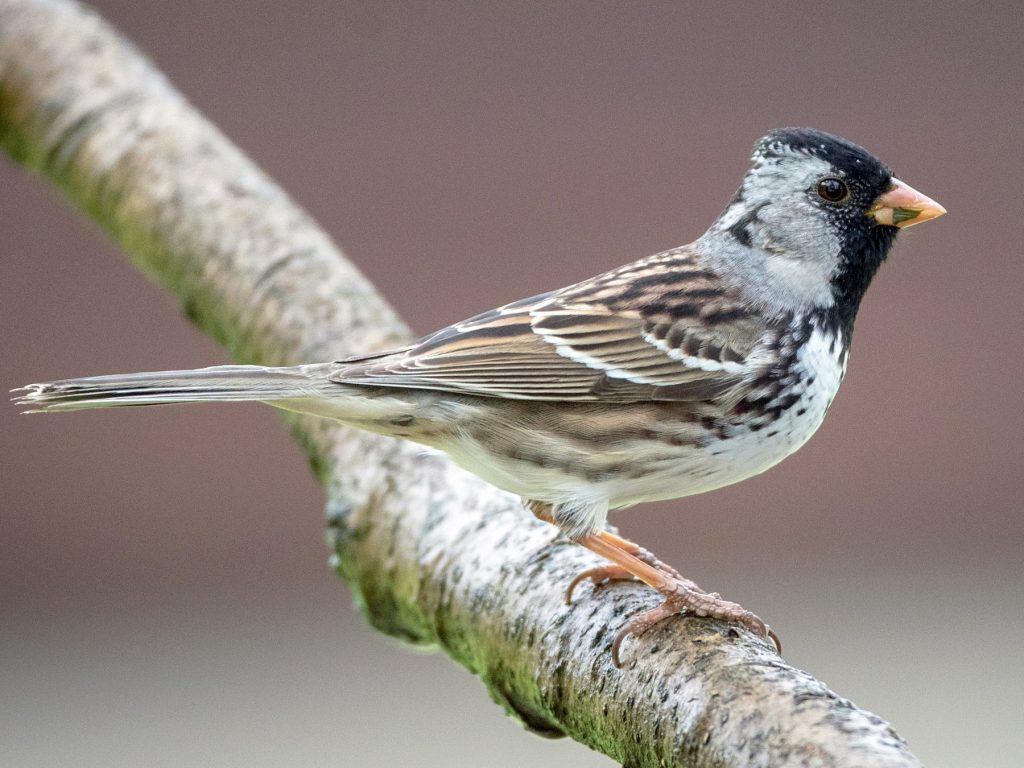
Harris’s Sparrows are uncommon in Maine and are primarily seen during their migration in the spring and fall.
Harris’s Sparrows have black heads with a bright pink bill and a black bib. Their backs are grayish-brown, and their undersides are whitish with streaks on the sides.
Zonotrichia querula
Length: 6.3-7.1 in (16-18 cm)
Weight: 1.2-1.5 oz (35-42 g)
Wingspan: 10.6 in (27 cm)
Harris’s Sparrows breed in the far northern regions of Canada, specifically in the tundra and boreal forests. During winter, they migrate to the central United States and occasionally parts of the East Coast.
You can find Harris’s Sparrows in shrubby areas, brushy fields, and forest edges. They often forage on the ground, scratching and hopping to uncover seeds and insects.
Harris’s Sparrow sounds: Their song is a series of clear, whistled notes that descend in pitch.
Credit: Lance A. M. Benner, XC659235. Accessible at www.xeno-canto.org/659235.
Harris’s Sparrows primarily feed on seeds, especially during the winter months when their diet is almost exclusively composed of seeds.
Nests of Harris’s Sparrows are built on or near the ground by females. They lay around 4-6 eggs, which take about two weeks to hatch. The young sparrows fledge within a week or two after hatching.
Fun fact: Harris’s Sparrows have the distinction of having the most northerly breeding range of any sparrow species.
13. Song Sparrow

Song Sparrows are common and widespread throughout Maine, both during the breeding season and as year-round residents.
Song Sparrows have brown upperparts with streaks, a grayish breast with a central spot, and a streaked belly. They have a round body shape and a long tail.
Melospiza melodia
Length: 5.5-7.5 in (14-19 cm)
Weight: 0.8-1.4 oz (22-40 g)
Wingspan: 7.9-9.1 in (20-23 cm)
Song Sparrows breed across most of North America and can be found in a variety of habitats, including marshes, shrubby areas, gardens, and woodland edges.
You can often hear Song Sparrows before you see them. Their song is a variable mix of musical notes, trills, and buzzes.
Credit: Mike Nelson, XC474988. Accessible at www.xeno-canto.org/474988.
Song Sparrows primarily feed on insects during the breeding season and switch to a diet of seeds and berries during winter.
Nests of Song Sparrows are built low in shrubs or on the ground by females. They lay around 3-5 eggs, which take about two weeks to hatch. The young sparrows fledge within a week or two after hatching.
Fun fact: Song Sparrows are known for their diverse repertoire of songs, and individual males can have over a dozen variations of their song.
14. Lincoln’s Sparrow
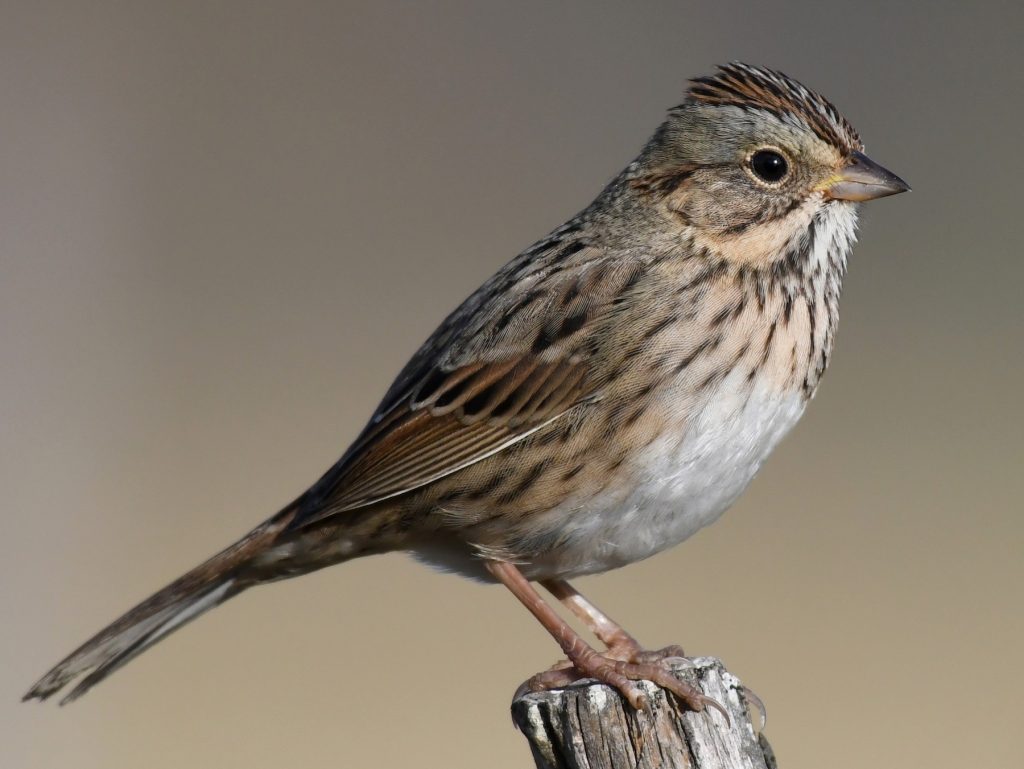
Lincoln’s Sparrows are not as common in Maine compared to some other sparrow species but can be seen during migration, particularly in wetland habitats.
Lincoln’s Sparrows have gray-brown upperparts with fine streaks, a buffy breast with streaks, and a white belly. They have a relatively short tail and a thin bill.
Melospiza lincolnii
Length: 4.7-5.9 in (12-15 cm)
Weight: 0.4-0.7 oz (11-19 g)
Wingspan: 7.1-7.9 in (18-20 cm)
Lincoln’s Sparrows breed in the boreal forests and tundra of Canada and Alaska. They migrate through the central and eastern United States, including Maine, during spring and fall.
You can find Lincoln’s Sparrows in wetland areas, such as marshes, bogs, and damp thickets. They forage on the ground, flipping over leaves to uncover insects and seeds.
Lincoln’s Sparrow sounds: Their song is a sweet and melodic series of musical notes, usually descending in pitch.
Credit: Andrew Spencer, XC446646. Accessible at www.xeno-canto.org/446646.
Lincoln’s Sparrows primarily feed on insects, spiders, and seeds. During migration, they rely more on seeds to fuel their long-distance flights.
Nests of Lincoln’s Sparrows are built low in shrubs or on the ground by females. They lay around 3-6 eggs, which take about two weeks to hatch. The young sparrows fledge within a week or two after hatching.
Fun fact: Lincoln’s Sparrows were named after Thomas Lincoln, an acquaintance of John James Audubon, who provided specimens for Audubon’s study.
15. Savannah Sparrow
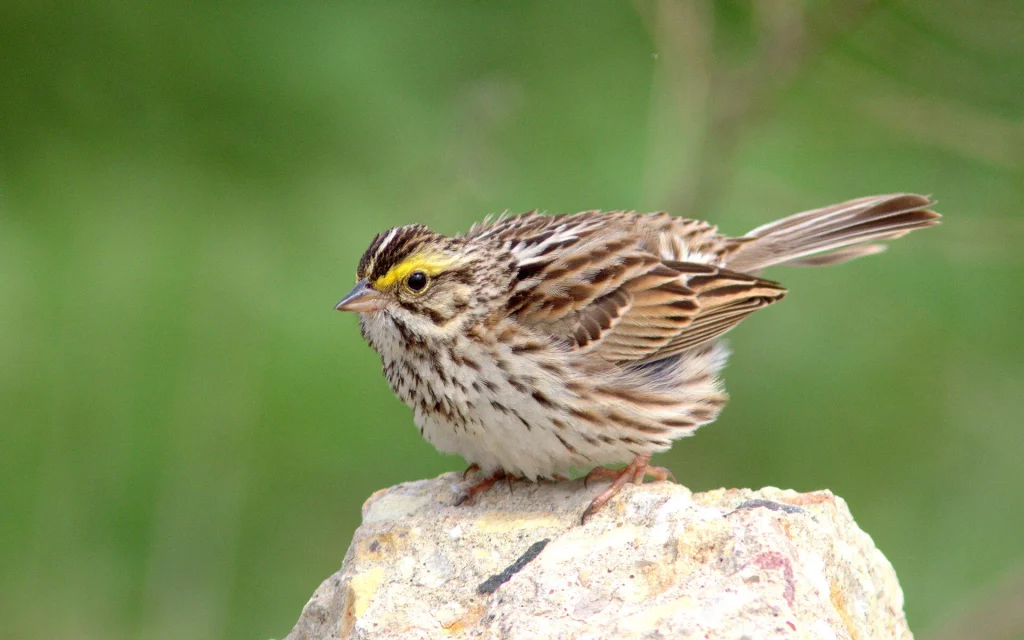
Savannah Sparrows are widespread and abundant in Maine, both during the breeding season and as winter residents along the coast.
Savannah Sparrows have streaked brown upperparts, a yellowish face with a dark eye stripe, and a whitish belly with streaks on the sides. They have a small and slim body shape.
Passerculus sandwichensis
Length: 4.7-6.3 in (12-16 cm)
Weight: 0.4-0.7 oz (12-20 g)
Wingspan: 7.5-9.1 in (19-23 cm)
Savannah Sparrows breed across a wide range of North America, including the Arctic tundra and grasslands. They can be found in various open habitats, including fields, meadows, marshes, and coastal dunes.
You can often hear Savannah Sparrows singing from perches, fences, or bushes. Their song is a series of thin, buzzy notes.
Credit: Rick Bohn, XC287883. Accessible at www.xeno-canto.org/287883.
Savannah Sparrows primarily feed on seeds, grasses, and insects. They forage on the ground, hopping and scratching to find food.
Nests of Savannah Sparrows are built on the ground by females. They lay around 3-6 eggs, which take about two weeks to hatch. The young sparrows fledge within a week or two after hatching.
Fun fact: Savannah Sparrows have different plumage variations across their range, and birds in the eastern United States tend to have more reddish-brown tones compared to western populations.
16. Swamp Sparrow
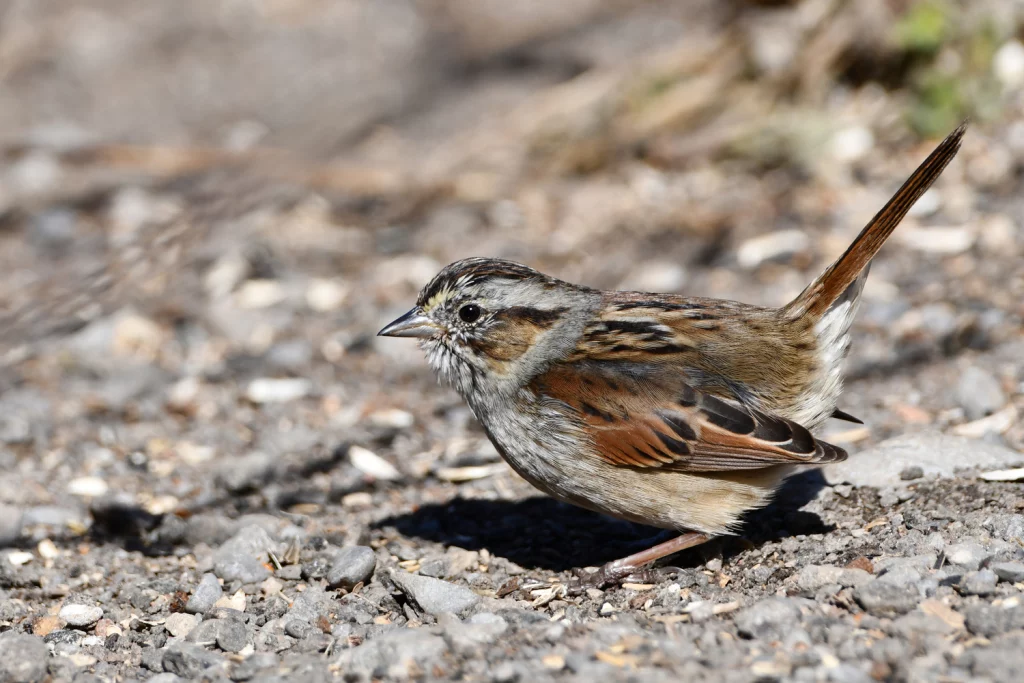
Swamp Sparrows are found in Maine during the breeding season and can be observed in wetland habitats such as marshes, bogs, and swamps.
Swamp Sparrows have a rusty crown and wings, gray breast and sides, and a white belly. They have a gray face with a dark eye line and a yellow spot in front of then eye.
Melospiza georgiana
Length: 4.7-5.5 in (12-14 cm)
Weight: 0.6-0.8 oz (17-23 g)
Wingspan: 7.5-8.7 in (19-22 cm)
Swamp Sparrows breed across much of eastern North America, including Canada and the northeastern United States. They are primarily found in wetland areas with dense vegetation.
You can often hear Swamp Sparrows singing from low perches or within dense vegetation. Their song is a series of clear, musical notes.
Credit: Daniel Parker, XC628795. Accessible at www.xeno-canto.org/628795.
Swamp Sparrows primarily feed on seeds, insects, and spiders. They forage on the ground, among low vegetation or at the water’s edge.
Nests of Swamp Sparrows are usually built close to the ground, hidden within dense vegetation. They lay around 3-5 eggs, which take about two weeks to hatch. The young sparrows fledge within a week or two after hatching.
Fun fact: Despite their name, Swamp Sparrows are not limited to swampy habitats and can also be found in drier areas with suitable vegetation.
17. Eastern Towhee

Eastern Towhees are year-round residents in Maine and can be observed in various habitats, including woodlands, thickets, and shrubby areas.
Eastern Towhees have a black head, throat, and upper body, with rufous sides and white underparts. The females have similar patterns but are brown instead of black.
Pipilo erythrophthalmus
Length: 6.8-8.2 in (17-21 cm)
Weight: 1.1-1.8 oz (31-52 g)
Wingspan: 7.9-11 in (20-28 cm)
Eastern Towhees breed across much of eastern North America, including Maine. They prefer habitats with dense understory vegetation and are often found foraging on the ground.
You can often hear Eastern Towhees singing from low perches or hidden in thick vegetation. Their song is a rich, musical phrase that sounds like “Drink your tea!”
Credit: Mike Nelson, XC474993. Accessible at www.xeno-canto.org/474993.
Eastern Towhees have a diverse diet, feeding on a variety of seeds, fruits, insects, and spiders. They use their strong bills to scratch through leaf litter in search of food.
Nests of Eastern Towhees are usually built on or near the ground, hidden within dense vegetation or shrubs. They lay around 2-6 eggs, which take about two weeks to hatch. The young towhees fledge within a week or two after hatching.
Fun fact: The name “towhee” comes from the distinctive call of the male Eastern Towhee, which sounds like “tow-hee.”
18. White-crowned Sparrow
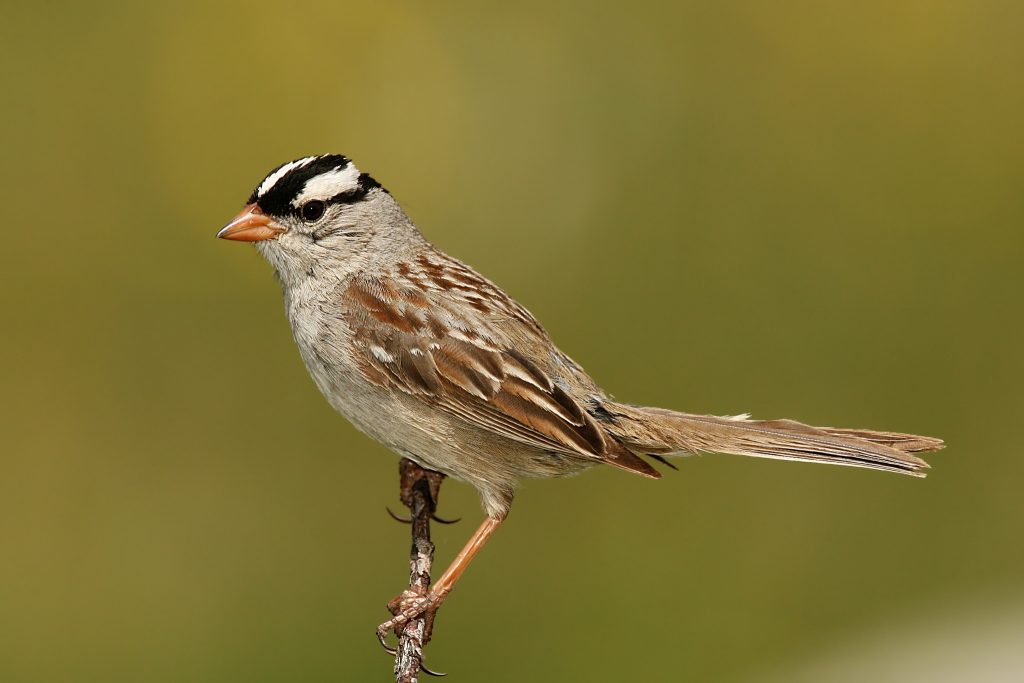
White-crowned Sparrows can be observed in Maine during migration, particularly in spring and fall, as they pass through on their way to breeding grounds in northern North America.
White-crowned Sparrows have a distinctive black and white striped head pattern, with a gray or brown body. The males typically have brighter and more defined head stripes compared to females.
Zonotrichia leucophrys
Length: 6.3-7.5 in (16-19 cm)
Weight: 0.8-1.4 oz (24-40 g)
Wingspan: 9.1-10.2 in (23-26 cm)
White-crowned Sparrows breed in northern North America, including Alaska and Canada. During migration, they can be found in a variety of habitats, including fields, wood edges, and brushy areas.
You can often hear White-crowned Sparrows singing from perches or while foraging on the ground. Their song is a series of clear, whistled notes.
Credit: Andrew Spencer, XC594399. Accessible at www.xeno-canto.org/594399.
White-crowned Sparrows have a varied diet, feeding on seeds, insects, and berries. They forage on the ground, scratching through leaf litter or pecking at seeds.
Nests of White-crowned Sparrows are typically built on or near the ground, hidden within dense vegetation. They lay around 3-5 eggs, which take about two weeks to hatch. The young sparrows fledge within a week or two after hatching.
Fun fact: White-crowned Sparrows have distinct regional dialects in their songs, and individuals in different regions may have slightly different song patterns.
19. Fox Sparrow
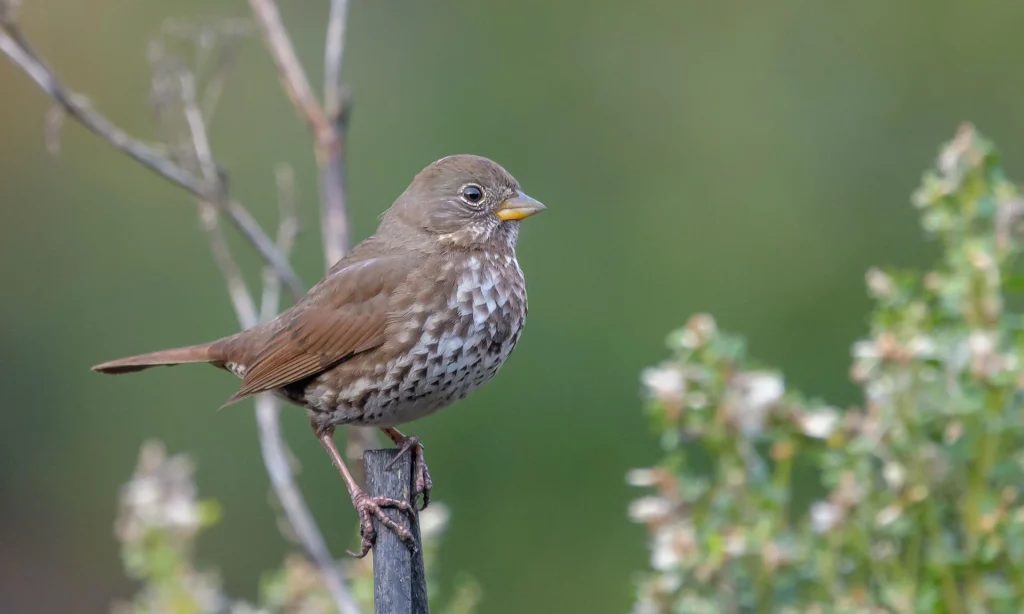
Fox Sparrows can be observed in Maine during migration, particularly in spring and fall, as they pass through on their way to breeding grounds in northern North America.
Fox Sparrows are large, chunky sparrows with a reddish-brown plumage, heavily streaked with dark markings. The coloration can vary among individuals and subspecies.
Passerella iliaca
Length: 5.9-7.5 in (15-19 cm)
Weight: 1.1-1.8 oz (31-51 g)
Wingspan: 9.8-11.4 in (25-29 cm)
Fox Sparrows breed in northern North America, including Alaska and Canada. During migration, they can be found in a variety of habitats, including woodlands, thickets, and shrubby areas.
You can often hear Fox Sparrows singing from low perches or while foraging on the ground. Their song is a rich, melodious series of musical notes.
Credit: Richard E. Webster, XC460439. Accessible at www.xeno-canto.org/460439.
Fox Sparrows have a diverse diet, feeding on seeds, fruits, insects, and invertebrates. They use their strong bills to scratch through leaf litter in search of food.
Nests of Fox Sparrows are usually built on or near the ground, hidden within dense vegetation or shrubs. They lay around 3-5 eggs, which take about two weeks to hatch. The young sparrows fledge within a week or two after hatching.
Fun fact: Fox Sparrows have a “double-scratch” foraging behavior, where they rapidly kick their feet back and forth to expose hidden food items beneath leaf litter.
20. Clay-colored Sparrow
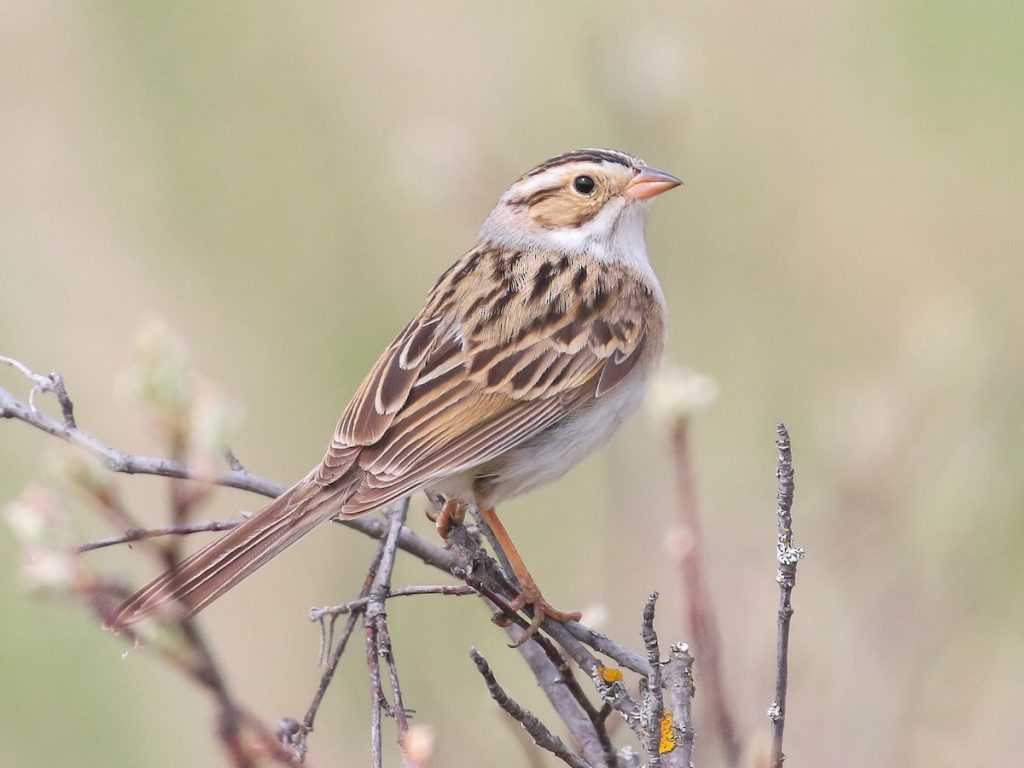
Clay-colored Sparrows are rare visitors to Maine during migration, and they can be observed in open habitats such as fields, prairies, and grasslands.
Clay-colored Sparrows have a plain appearance, with brownish-gray upperparts and pale underparts. They have a distinct pale crown stripe, which gives them their name.
Spizella pallida
Length: 4.7-5.5 in (12-14 cm)
Weight: 0.4-0.6 oz (11-17 g)
Wingspan: 7.1-8.3 in (18-21 cm)
Clay-colored Sparrows breed in the northern Great Plains of North America, including parts of Canada and the central United States. They migrate through the central and eastern regions of the continent.
You can often hear Clay-colored Sparrows singing from perches or while foraging on the ground. Their song is a buzzy, insect-like trill.
Credit: Bob McGuire, XC102056. Accessible at www.xeno-canto.org/102056.
Clay-colored Sparrows primarily feed on seeds, grains, and insects. They forage on the ground, scratching and pecking for food.
Nests of Clay-colored Sparrows are usually built close to the ground, hidden within vegetation or grass. They lay around 3-5 eggs, which take about two weeks to hatch. The young sparrows fledge within a week or two after hatching.
Fun fact: The Clay-colored Sparrow is known for its song, which resembles the trill of an insect. It is sometimes referred to as the “Buffy Sparrow” due to its Buffy-colored plumage.
